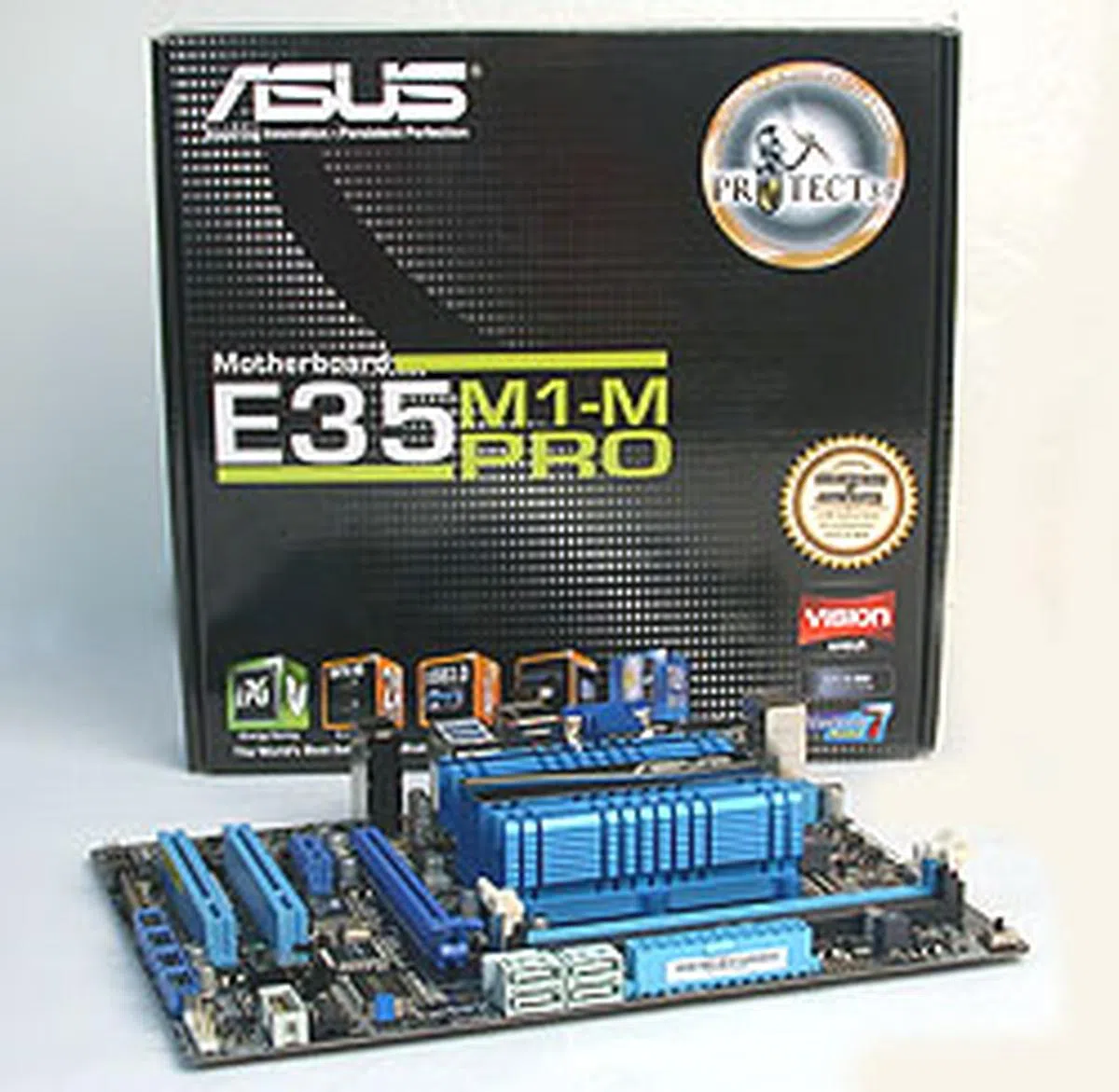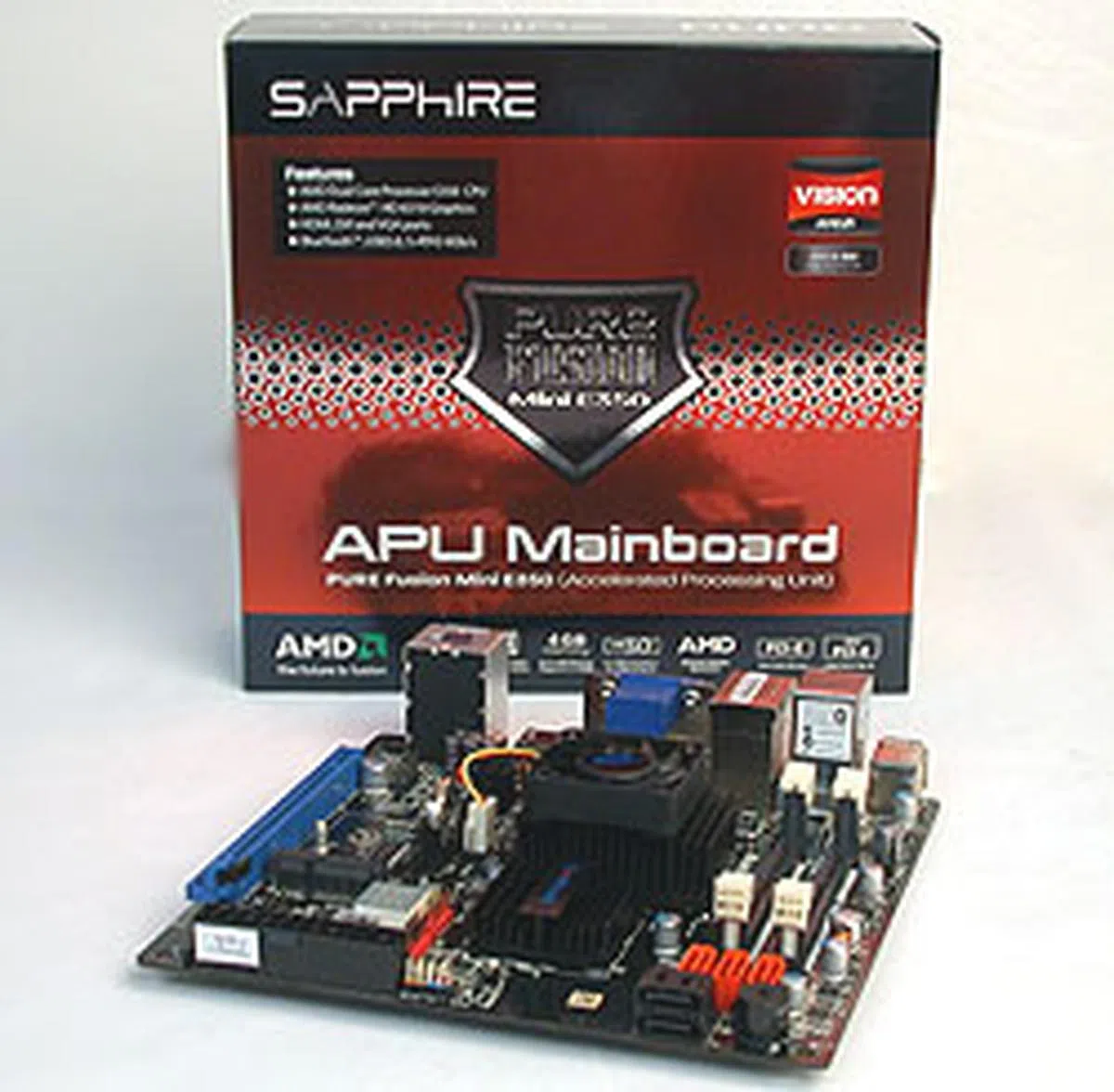More AMD Brazos Motherboards - ASUS and Sapphire Tested!
AMD's Brazos platform is off to a decent start, finding its way into mini notebooks and compact desktops. Two more such motherboards have arrived from ASUS and Sapphire. Find out if they meet our expectations.
A Tale of Two Boards
After all the excitement surrounding new CPU platforms from both AMD () and Intel (), the industry has settled down to churning out these new products. Intel had a slightly rough time due to a glitch in its Cougar Point chipsets (P67, H67), but the worst is over and revised Sandy Bridge motherboards have been making its way to the retail channels. With the next wave of new CPUs and motherboards not expected till the middle of the year, it gives us some time to catch up with the many boards that have made their way to our labs.
While there are plenty of choices when it comes to Intel based boards, new AMD boards are few and far in between. Not surprisingly, the ones we have seen are all based on AMD's Fusion initiative, using the Brazos platform which is targeted at the lower end of the market for both desktops and mobile. It's something that we have covered previously , and we personally feel that this platform has definite advantages over its competition in certain scenarios and price points.
AMD is expected to expand further on its Fusion theme with newer Accelerated Processing Units or APUs, as AMD calls these new breed of processors. These upcoming Llano APUs are reported to hit the market in July and will be more powerful (and more expensive) than the entry level Brazos. Whether they will be able to compete effectively against Intel is up for debate but we have seen enough of Brazos to feel reasonably optimistic.
In any case, it's all speculation at this point in time. What we do have here today are two more Brazos motherboards. Each comes with a Zacate APU (E-350 running at 1.6GHz) embedded within, so all you need to do is to slap on some memory modules, some storage and you're good to go. Like the other Brazos so far, they are in smaller form factors than the standard ATX, but while the Sapphire Pure Fusion Mini E350 keeps to the mini-ITX size we are familiar with, ASUS has opted for a larger micro-ATX form factor for its E35M1-M PRO. You can .

The micro-ATX ASUS E35M1-M PRO looks like a normal ATX board next to the mini-ITX Sapphire.
Click the jump to find out what we thought about these two Brazos boards.
ASUS E35M1-M Pro
While most of the manufacturers appear to favor the mini-ITX form factor, ASUS has gone with a micro-ATX design. Obviously, the benefits include more PCB space for features and ASUS has taken the liberty to include quite a mix of features, from puzzling ones like COM and LPT ports to the usual proprietary ASUS technologies that we didn't expect to find on an entry-level platform. If you're inclined towards the smaller mini-ITX form factor however, ASUS does have the E35M1-I DELUXE as an alternative.
Perhaps due to the freedom of having more space, ASUS is able to fit a completely passive heatsink for the CPU and chipset (or Fusion Controller Hub). This contrasts with the other Brazos motherboards we have seen, which all rely on a single small fan to cool the heatsink. It does mean that if a totally silent solution is the main criteria, this ASUS board is likely your best bet.
Besides the passive heatsink, the E35M1-M PRO is clad in the usual blue shades that ASUS has been using in recent times. The specifications of this board are fairly standard, with a single channel DDR3 memory architecture supporting up to 8GB of DDR3-1066 memory. The integrated graphics on the APU (Radeon HD 6310, clocked at 500MHz) can draw on this pool of system memory. The processing cores of course are at 1.6GHz, though it runs at 800MHz during idle moments, which helps account for the relatively low 18W TDP for the platform.

It's larger than many other Brazos motherboards despite being a micro-ATX form factor.

Due to the integrated graphics, there are three display outputs, VGA, HDMI and DVI. The other ports include USB 3.0, FireWire, eSATA and optical S/PDIF.

The ASUS has 1 more onboard SATA ports than the other Brazos boards we have seen. There's also an eSATA port at the rear panel. All SATA 6Gbps capable of course.

Some of the extra PCB space have been used to add more headers for USB, FireWire, COM and even LPT.

The USB 3.0 support comes from an ASmedia controller, a change from the more popular NEC controller. We assume cost is a reason for the switch. Besides the PCIe 2.0 x16 slot for a discrete graphics card, ASUS has also included two PCI slots. Also seen is the usual VIA FireWire controller.

The large single heatsink that cools the chipset and processor. We were surprised that there is no cooling fan on the heatsink.
Thanks to the spacious PCB, there are no layout issues on this board. Clearing the BIOS is easy with the jumper in clear sight and reach, while the SATA ports are mostly aligned properly at the edge of the board. The extensive support for legacy devices (no IDE though) does seem to suggest that ASUS is throwing everything at it and seeing what sticks. One gets the feeling that this board lacks a certain focus - we have no clear idea what market segment it is trying to reach with its blend of entry level performance and mid-range features.
This feeling is particularly strong when one plays with the UEFI BIOS on this board - it's similar to the BIOS that you'll find on ASUS' latest high-end boards (with the appropriate settings of course). There was an option to overclock the base clock and even an auto-overclocking utility. We wonder how many of the intended users for this board will bother to try them out. Take for example the numerous ASUS' technologies that are included. With the exception of the BIOS flashing utility, we bet none of them will see actual use.
We suppose it may cost ASUS little to nothing to implement these features, many of which are software based. At S$245, the ASUS E35M1-M PRO is not exactly that cheap compared to other Brazos boards (though Newegg has it for US$145, which when converted is just S$186).
Sapphire Pure Fusion Mini E350
Sapphire has gone with the popular mini-ITX route that most of the other Brazos manufacturers have opted for. While that is not surprising, we were however not too pleased with Sapphire's decision to go with SO-DIMM slots instead of full-sized DIMM slots. On hindsight, it's likely that Sapphire had no choice but to go with the smaller SO-DIMM due to space restrictions, but our initial impression was one of dismay since going with SO-DIMM is probably going to cause more hassle for the average user. After all, it's less likely that one has SO-DIMM memory modules lying around.
Once we got past the matter of getting the right memory, the cause for the use of SO-DIMM probably has to do with the presence of a mini-PCIe slot on this board. It's an interesting decision, though we have seen other vendors try that for boards of smaller form factors. While this Sapphire came without any mini-PCIe module, we can easily imagine savvy users installing their own to add functionality like Wi-Fi.
In fact, given the possible use-case scenarios for such a small Brazos system, we would have preferred Wi-Fi functionality out of the box, but at least Sapphire makes it easy enough to add that. Instead of Wi-Fi however, Sapphire did add a Bluetooth module, with the antenna protruding from the rear panel.
Besides what we have highlighted, the Sapphire Pure Fusion Mini E350 is similar to the other Brazos mini-iTX boards we have seen in terms of features. One gets a PCIe x16 slot for a discrete graphics card (which operates at x4 bandwonly) and up to five SATA 6Gbps ports, including an eSATA port at the back.

Sapphire has chosen a mini-ITX form factor, though we were initially surprised by the presence of SO-DIMM slots.

Besides the novelty of seeing a Bluetooth module on this board, the rear panel has the usual trio of display outputs, the audio jacks and optical S/PDIF output and even USB 3.0 ports.

Sapphire provides five SATA 6Gbps ports like the ASUS, which is one more than some other vendors.

The single PCIe 2.0 x16 slot along with the mini-PCIe slot.

We are not fans of SO-DIMM on desktops, even if they are small, mini-ITX ones. But we can guess the reason for doing so.

USB 2.0 headers for your casing's front panel, along with a debug LED.

The more conventional cooler fan heatsink combo that's found on most Brazos boards.
Despite the layout on the Sapphire being different from the other Brazos mini-ITX boards, we did not find anything serious that will affect its usability. Meanwhile, the BIOS used is also an UEFI variant from AMI and though there are boards with more options out there, the one on the Sapphire was pretty decent and usable. Obviously, this board came with rather basic options that suit its market segment.
Finally, we weren't able to obtain a local quote for this board, but Newegg has it listed at US$140, which is only slightly less than the ASUS E35M1-M PRO.
Test Setup
Since we had relative to others like NVIDIA's Ion or AMD's 785G, we will only be comparing the ASUS and Sapphire against the other Brazos boards from ASRock, Gigabyte and MSI.
The full set of motherboards compared:-
- ASUS E35M1-M PRO
- Sapphire Pure Fusion Mini E350
- ASRock E350M1
- Gigabyte E350N-USB3
- MSI E350IA-E45
The following system configuration is used for the testing:
AMD Brazos Platform
- AMD Zacate (1.6GHz)
- 2 x 1GB Kingston HyperX DDR3-1333 (CAS 7-7-7-20) for MSI and Gigabyte
- 2 x 1GB Kingston HyperX DDR3-1066 (CAS 7-7-7-20) for ASUS, ASRock and Sapphire
- AMD Radeon HD 6310 (integrated, Catalyst driver 8.792, 256MB shared memory)
- Seagate Barracuda 7200.10 SATA
- Windows 7 64-bit Ultimate
Benchmarks
The following benchmarks were used:
- Futuremark PCMark Vantage (ver 1.01)
- Futuremark 3DMark06 (ver 1.10)
- Far Cry 2
- Unreal Tournament 3 (ver 1.1)
- Quake 4 (ver 1.3)
- Blu-ray Playback Testing (Black Snake Moan, Superman Returns) using PowerDVD 10 (ver 2308)
Results - Futuremark PCMark Vantage
While the ASUS board was overall one of the better performers in PCMark Vantage, the Sapphire was rated the slowest. However, given the 3% difference between the two boards here, one could safely say that all five Brazos boards were very similar in performance. As you can tell from the modest PCMark scores, the Brazos platform is definitely entry-level caliber.




Gaming Benchmarks
3DMark06 split the five boards into two groups, with the ASUS, ASRock and Sapphire falling slightly behind as a result of their slower DDR3 1066MHz memory. While the memory frequency likely explained the scores in the synthetic benchmark, it was less of a factor in the actual games. In two of the three games, we found the Sapphire to be marginally the slowest.
Of course in Far Cry 2, the relatively low frame rates that we got meant that users are unlikely to have a passable game experience without lowering the settings further.




HD Playback Performance
When it comes to playing a Blu-ray disc on these Brazos systems, there are no issues like lag or artifacts. CPU utilization was relatively low since hardware acceleration is supported and the GPU component of the Zacate APU is the one doing the heavy lifting here. We saw some fluctuation among the numbers for the ASUS and Sapphire, but even then, the highest we saw was 25% CPU usage, which is comfortably within our tolerance.

Power Consumption
Power consumption for the ASUS was a bit higher than the other boards; the larger microATX form factor and its features probably accounted for this. Besides that, the Sapphire was in line with the other Brazos boards, which in this case meant a maximum draw of just 63W at peak. Such relatively low power consumption is undoubtedly one of the strong points about this platform, making it suited for less demanding tasks like browsing the internet, media consumption and light productivity workloads.

Conclusion
With a small but important handful of board manufacturers choosing the Brazos platform, it has a decent chance of carving a niche. Its entry-level price coupled with competent media playback capabilities and low power consumption makes it attractive to certain users who know exactly what they require. These are the users who prefer not to cut a steak with a claymore if a smaller knife can do the job equally well. Unfortunately for AMD, there probably aren't that many such users out there demanding Brazos systems. As such, one is more likely to find Brazos within the thin and light notebook segment, or a ready-made nettop machine than your next desktop machine.
Nevertheless, if you're one of those who have done your research and find AMD's Brazos perfect for your needs, likely as a HTPC system, then you're somewhat spoiled for choice. Counting the two boards under review today, we have seen a total of five models from five different manufacturers (and some like ASUS have multiple SKUs that we haven't yet covered). While the earlier three that we saw from ASRock, Gigabyte and MSI were mostly similar, from the features to the layout and even the performance (well the DDR3 1333MHz boards have the slightest of advantages), the ASUS and Sapphire boards seen in this article are quite different.
The ASUS E35M1-M PRO should fill in adequately as the base for a desktop machine for light office and home use. It has support for many devices, including older ones that are frankly not very useful nowadays. Given the luxury of the larger microATX form factor, we suppose ASUS was just trying to be thorough. The silent heatsink does get a thumbs up from us. It also has a surprisingly full fledged BIOS, including overclocking options. We doubt there is much leeway or reason to overclock however. Finally, the local retail price is a tad expensive compared to the rest (the next most costly is the Gigabyte GA-E350N-USB3 at S$239). One could argue that the larger PCB on the ASUS adds to the cost, but personally, we felt that unless one really needs the expansion options, mini-ITX is fine for what this platform does.
As for the Sapphire Pure Fusion Mini E350, our initial dismay at its SO-DIMM slots was tempered once we studied the whole board. It was probably a concession to enable the mini-PCIe slot, which is useful for adding features like Wi-Fi. Therefore, while the Sapphire has fewer features on paper compared to the ASUS, it is a leaner and in some cases, more appropriate set of features. Unfortunately, the Sapphire tended to finish last or near the bottom in our benchmarks. It may not be significant to the end-user but it was consistently behind the rest. The US$140 price tag is somewhat competitive, but once you factor the need to get SO-DIMM memory (which does cost a little more), the value proposition of the board isn't at the same level of the other models we've seen.
Model | Features | Performance | Value | Overall | Retail Price |
ASUSE35M1-MPRO | 8.0 | 8.5 | 8.0 | 8.5 | S$245 (US$145) |
Sapphire Pure Fusion Mini E350 | 8.5 | 7.5 | 7.5 | 8.0 | US$140 |
 |  |
 |  |
Our articles may contain affiliate links. If you buy through these links, we may earn a small commission.